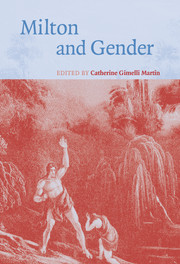Book contents
- Frontmatter
- Contents
- List of illustrations
- Notes on contributors
- Acknowledgments
- Abbreviations
- Introduction: Milton's gendered subjects
- PART I MASCULINITY, DIVORCE, AND MISOGYNY IN MILTON'S PROSE
- PART II THE GENDERED SUBJECTS OF MILTON'S MAJOR POEMS
- 4 The profession of virginity in A Maske Presented at Ludlow Castle
- 5 The genders of God and the redemption of the flesh in Paradise Lost
- 6 Transported touch: the fruit of marriage in Paradise Lost
- 7 The experience of defeat: Milton and some female contemporaries
- 8 Samson and surrogacy
- 9 “I was his nursling once”: nation, lactation, and the Hebraic in Samson Agonistes
- 10 “The Jewish Question” and “The Woman Question” in Samson Agonistes: gender, religion, and nation
- PART III GENDERED SUBJECTIVITY IN MILTON'S LITERARY HISTORY
- Index
10 - “The Jewish Question” and “The Woman Question” in Samson Agonistes: gender, religion, and nation
Published online by Cambridge University Press: 22 September 2009
- Frontmatter
- Contents
- List of illustrations
- Notes on contributors
- Acknowledgments
- Abbreviations
- Introduction: Milton's gendered subjects
- PART I MASCULINITY, DIVORCE, AND MISOGYNY IN MILTON'S PROSE
- PART II THE GENDERED SUBJECTS OF MILTON'S MAJOR POEMS
- 4 The profession of virginity in A Maske Presented at Ludlow Castle
- 5 The genders of God and the redemption of the flesh in Paradise Lost
- 6 Transported touch: the fruit of marriage in Paradise Lost
- 7 The experience of defeat: Milton and some female contemporaries
- 8 Samson and surrogacy
- 9 “I was his nursling once”: nation, lactation, and the Hebraic in Samson Agonistes
- 10 “The Jewish Question” and “The Woman Question” in Samson Agonistes: gender, religion, and nation
- PART III GENDERED SUBJECTIVITY IN MILTON'S LITERARY HISTORY
- Index
Summary
Milton is England's most Hebraic writer and Samson Agonistes his most Hebraic work. Published in 1671 when Milton was living in seclusion – a prophet in a nation that had not followed his advice but had embraced the idolatry of monarchy and the Church of England – this closet drama retells the narrative from Judges in Restoration England, using the Hebrew Bible and Jewish history to understand England's recent experience and present moment.
Debates about Samson Agonistes have revolved around whether Samson is a hero, and whether or not the poem shows Samson's “regeneration.” There has also been interest in the representation of woman and the feminine in Samson Agonistes, with some critics attempting to redeem Dalila from the misogynous charges voiced in the poem. I argue that Milton's Hebraism, his use of the Hebrew Bible, is inseparable from the representation of women and gender in the poem and the question of Samson's “heroism.” In this drama about an “Ebrew” (SA 1319) raised to “deliver” “Israel” (39), the “Woman question” is embedded in “The Jewish question,” as Milton transforms the narrative from Judges in ways that devalue both the Israelites and women. Implying a parallel between Israel and England, Milton presents a “manly,” muscular spirituality and an implicitly Christian liberty that are achieved only as Samson separates from the Israelites, Dalila, and what in the poem is marked as feminine, all of which Milton associates with bondage.
- Type
- Chapter
- Information
- Milton and Gender , pp. 184 - 204Publisher: Cambridge University PressPrint publication year: 2005
- 1
- Cited by

